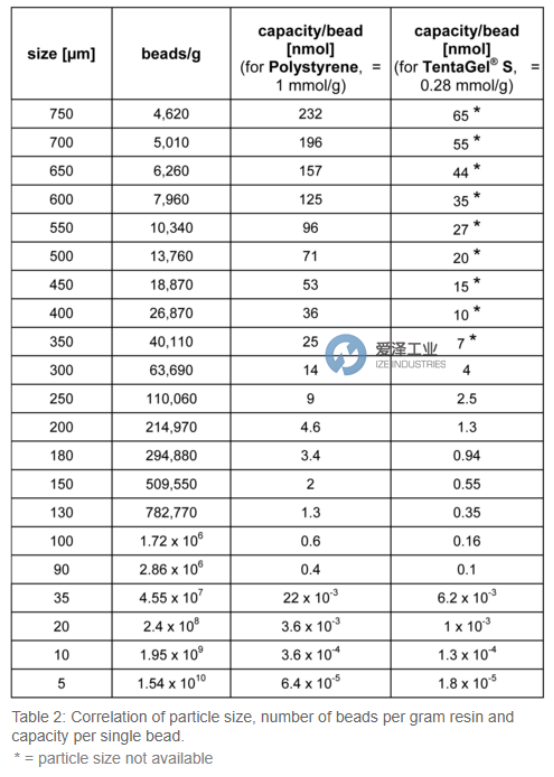TENTAGEL树脂类型及粒径介绍
TentaGel resin types
There are several types of TentaGel resins available showing tailored properties dependent on their application:
TentaGel S resin
The PEG spacer is attached to the polystyrene backbone via an alkyl linkage. This linkage is not sensitive towards acids or bases. This type of resin is a standard type of resin used for peptide synthesis, solid phase organic synthesis or combinatorial chemistry.
TentaGel M resin
The PEG spacer is attached to the polystyrene backbone via an alkyl linkage. This linkage is not sensitive towards acids or bases. This resin is microspherical and monosized and was developed for applications in automated sorters, for creating huge libraries, for high speed synthesis etc.
TentaGel MB resin
The PEG spacer is attached to the polystyrene backbone via an alkyl linkage. This linkage is not sensitive towards acids or bases. The macrobead resin shows extraordinary large particle diameters and high capacities and is designed for single bead synthesis, single bead analysis and single bead assays.
TentaGel B resin
The PEG spacer is attached to the polystyrene backbone via an alkyl linkage. This linkage is not sensitive to acids or bases. This resin type exists in two bifunctional species:
- Surface modified resins: the reactive sites on the outer surface of the beads are protected orthogonally to the reactive sites in the internal volume of the beads
- Hybrid resins: cleavable and noncleavable ligands are present in this support – developed for sequentional cleavage.
TentaGel R resin
The PEG spacer is attached to the polystyrene backbone via an alkyl linkage. This linkage is not sensitive to acids or bases. The resin is special suited for research purpose synthesis. It shows an increased swelling volume but is less pressure resistant. This makes the resin an ideal support for large peptides and difficult sequences.
TentaGel HL resins
The PEG spacer is attached to the polystyrene backbone via an alkyl linkage. This linkage is not sensitive to acids or bases. This highloaded version of TentaGel combines a significant higher capacity with the advantages of TentaGel resins
TentaGel N resin
These tailored resins are used in oligonucleotide chemistry for small and large scale oligonucleotide synthesis. In comparison to CPG glass the capacity is increased by a factor of 10. Special coupling protocols are needed.
TentaGel PAP resin
The PEG spacer is attached to the polystyrene backbone via a benzyl ether linkage. This benzyl ether linkage is sensitive to harsh acid conditions like 100% TFA or mixtures of TFA/trimethylsilyl bromide.
This specially tailored resin is used for immunization procedures or for synthesizing PEG modified derivatives (PEG Attached PEG-modified compounds). Using strong acid conditions, the PEG spacer is cleaved from the solid support together with the synthesized compound. Thus, soluble PEG modified compounds ( e.g. PEG modified peptides) are synthesized by applying solid phase methods.
Particle size
Setting up a chemical library or peptide library by the "one bead one compound" approach it is essential to know the number of beads which are available within a certain amount of resin as well as the capacity of single beads. Table summarizes some particle sizes and correlates them to the corresponding capacity of a single bead. The calculations are based on a typical loading of TentaGel beads which are in the range of 0.25 - 0.3 mmol/g. For analytical characterization at least 5 pmol of resin-bound peptide are needed for sequencing on a bead. In order to estimate the optimum resin quantity for the library which can be handled economically one has to take into account the bead sizes and bead capacities. In respect to homogeneity of diffusion process and kinetic rates as well as for single bead analysis and single bead quantification, all beads show a very narrow size distribution.
Particle Size Correlation Table

声明:
- 文章转载自网络,如有侵权,请联系删除!
- 如有偏颇,欢迎指正!

 沪公网安备31011002006738号
沪公网安备31011002006738号

